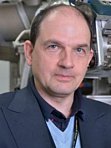A5: Growth, structure and magnetic properties of ultra thin transition metal oxides on metals
It is the aim of the project to study the growth and the geometric structure of functional oxide surfaces and interfaces. In this context we focus on the investigation of magnetic and ferroelectric systems which are at the heart of tunneling magneto resistance devices. We use surface x-ray diffraction (SXRD) in combination with scanning tunneling microscopy (STM) and low energy electron diffraction (LEED). We also plan to exploit x-ray absorption spectroscopy to analyze locally ordered structures.
Projects proposed in the previous application were competed successfully. The results of these investigations represent a significant advance in knowledge. For instance it could be shown that for ultrathin two unit cells thick films of BaTiO3 (BTO) which were grown on the (001) surfaces of Fe, Pd and Pt, a change in the terminating layer occurs, namely from BaO observed for BTO/Fe(001) to TiO2 for BTO/Pt(001) [Phys. Rev. Lett. 111, 105501 (2013)]. On the other hand, at the interface to the metal substrate in any case a TiO2 layer is found. In collaboration with theoretical investigations carried out in projects (TP) A4 and B2 it could be shown that the incorporation of oxygen and carbon atoms at the metal/BTO interface is responsible for the change of the termination of the film at the surface resulting from a modification of the charge density within the film. This finding opens a path to actively modify the termination of the films, i.e. to prepare either a symmetric [metal/TiO2-BaO....-TiO2] or an asymmetric film [metal / TiO2‑BaO....TiO2‑BaO]. This might be decisive for the optimization of the tunneling magneto resistance (TMR) amplitude.
Another important project of the previous period was the solution of the so far unknown structure of the (2x1) reconstructed (001) surface of single crystalline BTO [Phys. Rev. Lett. 108, 215502 (2012)]. The structure of the (2x1) reconstruction was solved by applying classical Fourier techniques. It was found that the BTO(001)-(2x1) reconstructed surface is characterized by a TiO2 double layer, in which the topmost TiO2 layer contains a Ti atom which is shifted out of its bulk position and residing in a fivefold coordination in the center of a tetragonal pyramid. Based on the structure determination, calculations carried out by TP A4 have indicated that the surface is metallic and that several atoms aquire large magnetic moments.
Based on the results of previous investigations of this and other projects [TP A1 (Alexe, Hesse), A3 (Widdra) und A10 (Parkin), we plan to continue our investigations by focusing on more complicated systems. The first example is the multiferroic heterostructure based on perowskite type oxides such as Co/PbZr0.2Ti0.8/La0.7Sr0.3MnO3 (Co/PZT/LSMO). A number of experimental and theoretical studies exists regarding the optimization of the TMR and the tunneling electro resistance (TER). By contrast, nothing is known with regard to the atomic structure of the films, their termination and the interfaces. Their determination is expected to provide an important contribution to the understanding of the unknown mechanisms responsible for the change of the sign of the TER amplitude upon polarization switching of the ferroelectric tunneling barrier. Furthermore, it is planned to determine the structure of the recently discovered two-dimensional oxidic quasicrystal (see project A3, Widdra) and its periodic approximant. Finally, in collaboration with the new project A10 (Parkin) we propose to investigate the film and interface structure of the heterosystem LaFeO3/SrTiO3. The formation of a two-dimensional electron gas is observed if the thickness of the LaFeO3 film exceeds about five unit cells, but metallic conductivity is suppressed by thermal treatment in oxygen at a temperature of about 1000 °C. The detailed analysis of the film and interface structure is expected to provide an explanation for this observation.
Principal Investigators
|
PD Dr. Holger Meyerheim ⇒
phone: +49 (0) 345/55 82633 fax: +49 (0) 345/55 11223 |

|


